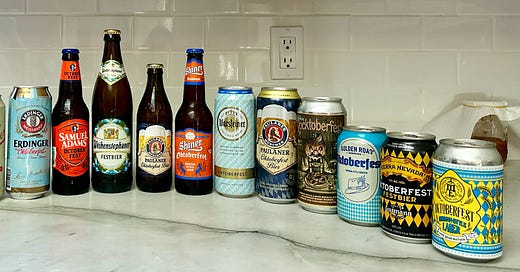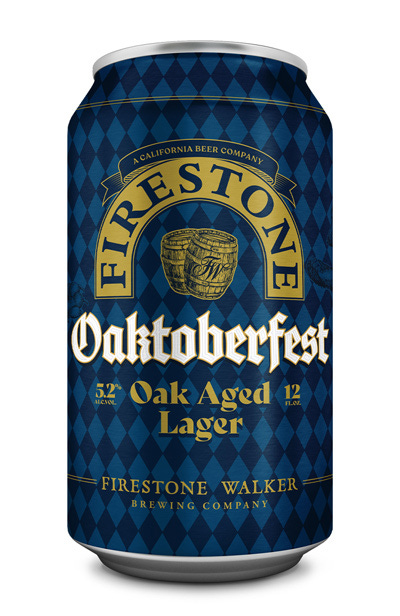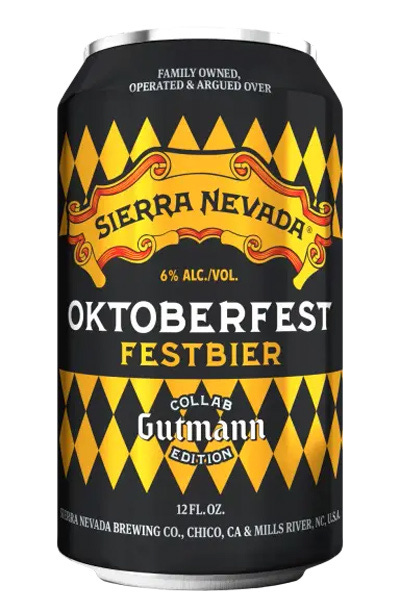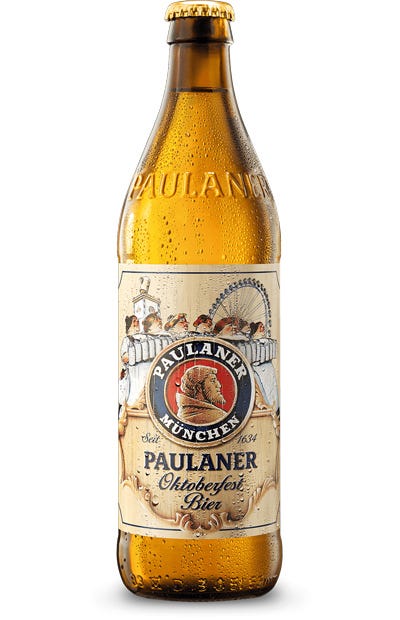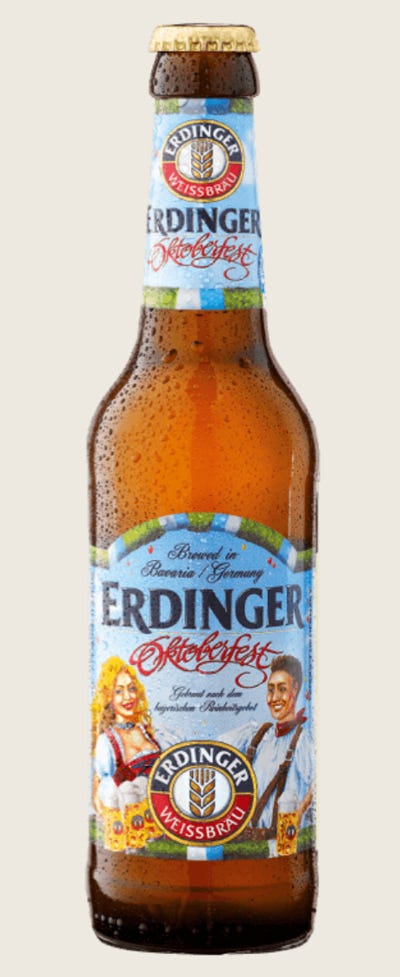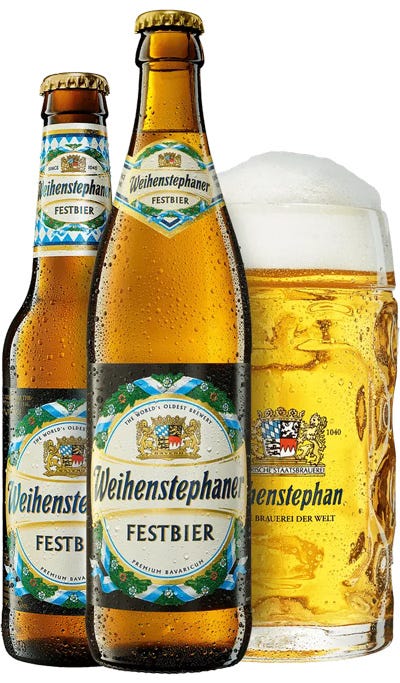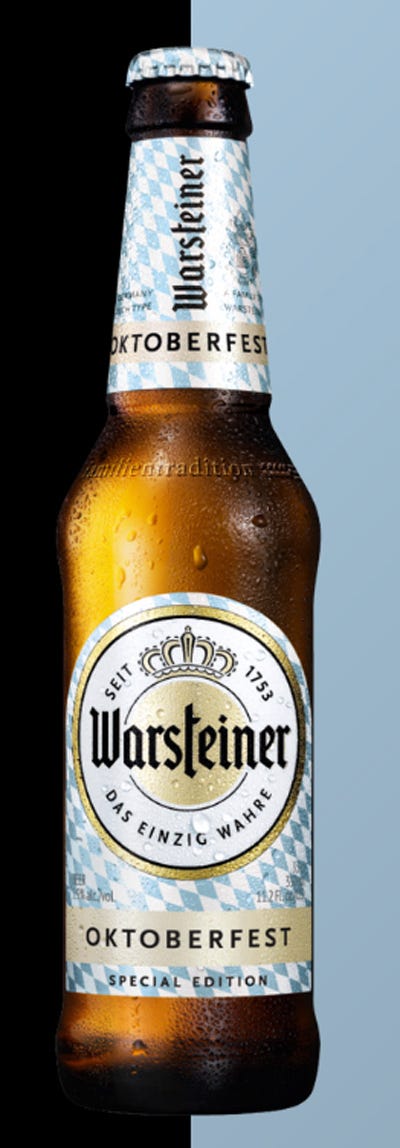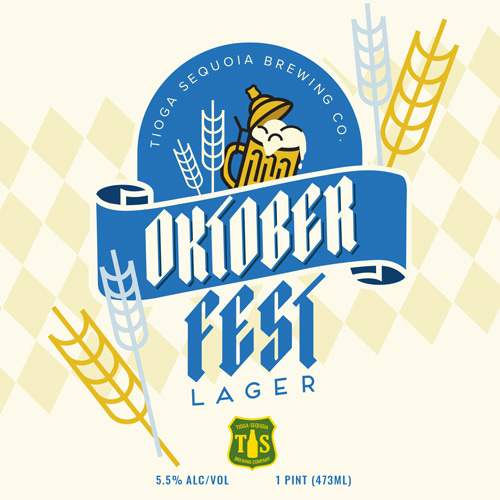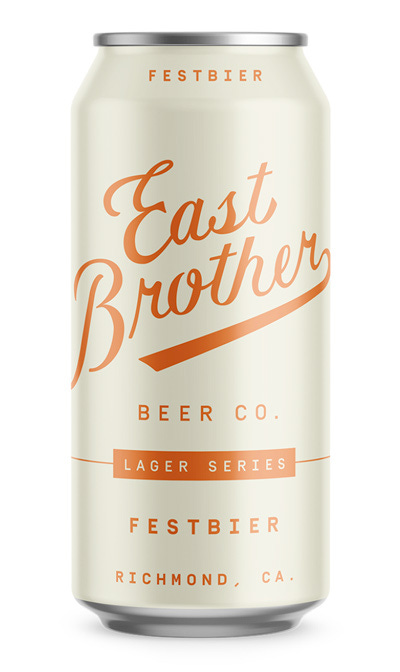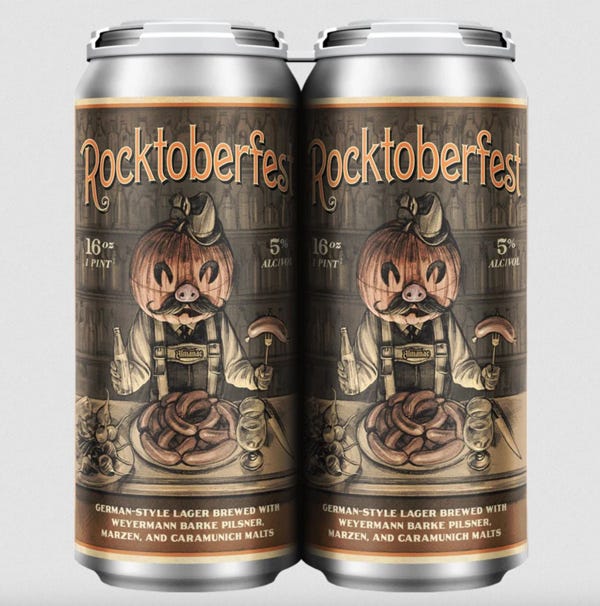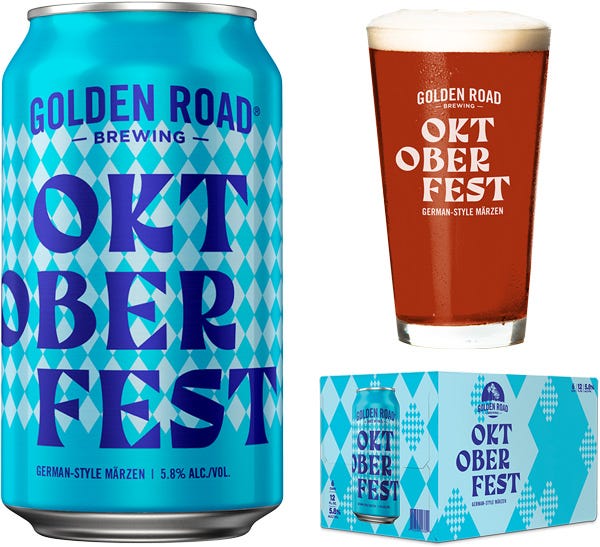Welcome to The #Content Report, a newsletter by Vince Mancini. I’ve been writing about movies, culture, and food since I started FilmDrunk in 2007. Now I’m delivering it straight to you, with none of the autoplay videos, takeover ads, or chumboxes of the ad-ruined internet. Support my work and help me bring back the cool internet by subscribing, sharing, commenting, and keeping it real.
—
I’ve said it before, but Oktoberfest beer season is my personal pumpkin spice. I spend all year waiting for it, rubbing my grubby little paws together in anticipation. For the other 11 months of the year, most of the breweries and restaurants I frequent stock six different taps with various iterations of IPA, DIPA and NEIPA, along with one apology blonde and an undrinkable stout made from nougat and horchata. Yet for 30-40 glorious days in early Fall, it’s my turn to feel seen, with at least one rotating tap dedicated to a beer style I actually enjoy.
That’s because I am what scientists refer to as a “Dark Lager Daddy.” I’m not a big fan of sweating piney hops through my neck pores after spending all week in line for the limited edition Pliny the Lumberjack quintuple IPA served in a pinecone, but I positively adore a little roasty malt with some velvety head (don’t make the joke, you’re better than that). I can drink a Vienna lager all year round (God bless Negra Modelo), but in the fall I get to binge (responsibly) on Märzens. My ideal Märzen looks like a watered-down root beer and tastes like a freshly baked biscuit slathered in caramel. Or whatever the delicious-sounding beer version of that is. Descriptions fail at a certain point, but folks? It’s good!
Märzens came from Bavaria and were traditionally brewed in the winter (Märzen = March) and then barrelled and drunk during the fall. Most German breweries switched from caramel-colored Märzens to straw-shaded Festbier (a lighter lager) in the 1990s (cheaper, and easier to drink lots of at an all-day drink fest). That’s why the German macrobreweries’ “Oktoberfest bier” tends to be Festbier while the American version is mostly still Märzen. Though of course, plenty of smaller American brewers have now started doing their own crafty versions of Festbier as well. I like them both, but tend to prefer a Märzen, which are generally sweeter and less bitter (though also sometimes with rum-raisiny notes that I don’t enjoy as much).
For this tasting, I just bought every “Oktoberfest” beer I could find, which ended up being a mix of Märzens and Festbiers. Since it’s no fun to taste beers alone, I brought along my friend Carlos, who unlike me is an IPA enthusiast who loves his hops. A real Pinecone Pápi, if you will. As you might expect, there ended up being a lot of variation in our rankings. And yet we did come to a consensus on our number one. And his lowest-ranked was tied for lowest in my rankings. With just a week to go before the election, it just goes to show that there are some things on which Americans can agree.
Anyway, if we missed your favorite brewery’s Oktoberfest here, it’s probably just because I couldn’t find it (also, I hate you). Honestly, you have only yourselves to blame for not sending me a bottle, can, or keg.
10 (tie): Firestone Oaktoberfest
Rating: 6/10
Tasting Notes (tasted 10th): Straight orange color, looks almost like Fanta. Can’t smell much on the nose. Maybe pear orange? Along with some light spice. Doesn’t taste like much either. It’s very drinkable, just not super memorable.
Concluding Thoughts: Firestone is a brewery in San Luis Obispo who’ve been doing craft beer since before craft beer was even really a thing. I’ve been there many times and I buy Oaktoberfest every year — it’s a Festbier aged in French oak barrels. That seems like a fresh angle on Oktoberfest beers, but it turns out I just don’t enjoy it quite as much as some of the others. It sounds like it would have the most character, thanks to the barrel aging, but ended up having the least. That being said, everything on this list was the kind of beer I would order at a bar and happily get seconds of.
Carlos’s Ranking: 7th out of 15. “Easy to drink.”
10 (tie): Sierra Nevada
Rating: 6/10
Tasting Notes: Pear orange in color and lightly cloudy. Pear/peach on the nose. On the palate, this one has a weird, aromatic honeysuckle/stone fruit vibe. It’s very different from the others, and more bitter than malty. Don’t love it, don’t hate it.
Concluding Thoughts: Sierra Nevada, out of Chico, California, is another craft beer pioneer that’s still around. Their Oktoberfest is a collaboration with German brewer Brauerei Gutmann, and it’s another Festbier, rather than a Märzen, which probably accounts for the lower ranking. I’m nothing if not predictable.
Carlos Ranking: 13th out of 15. “More like a hefeweizen.”
10: Paulaner Oktoberfest Bier (in the bottle)
Rating: 6/10
Tasting Notes (tasted 15th): Another light pilsnery one. Smells like a German macrobrew. I would bet a lot on that. On the palate… It’s fine! I could get used to drinking this one, but it doesn’t really do anything for me one way or the other. It’s like a better version of Bud Light (and I’m from the Central Valley so that’s a compliment).
Concluding Thoughts: Hey, it’s a German macrobrew. They’re all pretty solid, if unspectacular. Would happily drink this over IPA all night.
Carlos Ranking: 6th out of 15. “Smooth drink but light and fluffy on the back.”
9: Erdinger Oktoberfest
Rating: 6.5 out of 10
Tasting Notes (tasted 14th): This one is orange, cloudy and soapy looking. Looks like a hefe. What is that on the nose? Pear? Orange and coriander? Sort of fruity and vaguely spicy. Smells almost like wine. Taste-wise, the sweet and hops are kind of in balance, but very different from the others. It’s not bad but very much an outlier in this group.
Concluding Thoughts: Erdinger is one of the big German brewers (tenth biggest, per Wikipedia), and interestingly, this one wasn’t immediately identifiable as a German macrobrew. Perhaps that’s because, unlike the others, it’s a wheat beer: “ERDINGER Oktoberfest expertly combines smooth malt aromas with a pronounced hop bitterness. This well-balanced flavour is complemented by gently sparkling carbonic acid to give it the typical liveliness of a genuine wheat beer,” per the website. Probably why I was getting those wheaty notes.
Carlos Ranking: 13th out of 15. “Full-bodied but bitter.” (Much like your mom).
8 (tie): Weihenstephaner Festbier
Rating: 7/10
Tasting Notes (tasted second): Paler yellow in color, with not much head. Ever so slightly cloudy. Smells pilsnery and German with kind of a uriny nose. This has to be a German one. Very balanced flavor though, a mild macro brew that’s lightly sweet. I could crush a lot of these.
Concluding Thoughts: Weihenstephaner is possibly my favorite brewery, though I don’t like this one nearly as much as their original, hefe, or dunkel. Per the website, “Festbier is delicious with simple dishes, roasted chicken and flavorful Alpine cheese.”
Ah, yes, just roasting some chickens while sampling flavorful Alpine cheese. That’s a new life for myself that I just now started imagining. Sounds good, man.
Carlos Notes: 9th out of 15. “German beer, tastes more like a pils.”
8: Paulaner Oktoberfest (in the can)
Rating: 7/10
Tasting Notes (tasted 7th): Lighter golden color, looks more like a German pils. Smells like a German pils plus maybe hint of pear. Very bity and light. Drinkable, but tastes like a sort of boring macrobrew.
Concluding Thoughts: Yes, I accidentally bought this one in both the bottle and the can, and they tasted (slightly) different. I had the can slightly higher, Carlos had the bottle. Go figure.
Carlos Ranking: 15th out of 15. “Sweet.”
7: Warsteiner Oktoberfest
Rating: 7.25/10
Tasting Notes (tasted 3rd): Orange gold in color, not cloudy. No nose? Can’t get much aroma. Very mild taste, leaning towards Pilsner, though sweeter than the other pilsnery ones. Less crackery/biscuit flavor. “Crushable,” let’s say. That’s one of those craft beer terms it sounds like a craft beer guy came up with while half drunk.
Concluding Thoughts: Warsteiner is “Germany’s largest privately-owned brewery.” I didn’t think it was the best or the worst of the big German festbiers, but it’s certainly one of them.
Carlos Ranking: 12th out of 15. “Malty taste but very thin.”
6: Tioga Sequoia Brewing Oktoberfest Lager
Rating: 7.3/10
Tasting Notes (tasted 4th): This one looks darker, more like an American Oktoberfest. More like Negra Modelo. Raisiny on the nose. Definitely has some of that rum raisin malty flavor. Sweet and sort of liquory, with almost no bitter bite. A little syrupy for my taste.
Concluding Thoughts: Tioga-Sequoia is from right here in Fresno, so your mileage may very on being able to actually get it. Still, it’s the only true local in the contest on account of they actually sell it in cans.
They say: “Our German inspired [sic], malt driven [sic] amber lager is one of the best ways to experience oktoberfest [sic] in the central valley of california [sic]. This full flavored [sic] lager brings balance [sic] of clean, hop bitterness with biscuit-like malt aroma and flavor. celebrate [sic] fall with us and enjoy this seasonal treat while you can [sic]”
Guys, get a copyeditor, you’re embarrassing me.
Carlos Ranking: 8th out of 15. “no nose, a bit sweet and raisiny.”
5 (tie): East Brother Festbier
Rating: 7.5/10
Tasting Notes (tasted 1st): Orange-yellow color and slightly cloudy. Hint of orange on the nose. On the palate, biscuity malt flavor, mild sweetness, not really bitter at all. More crackery. Easy drinker, not too malty.
Concluding Thoughts: East Brother, out of Richmond, California, is another one of my favorite breweries, though I could be unduly swayed by their handsome cans. They make a Red Lager that’s one of my favorite beers, and probably to differentiate them, they do a Festbier for Oktoberfest rather than a Märzen. I’d probably still prefer a märzen, but this is a damned solid Festbier.
They say: “A smooth, clean, pale German lager with a moderately strong malty flavor and a light hop character. Deftly balances strength and drinkability, with a palate impression and finish that encourages drinking. Showcases elegant German malt flavors without becoming too heavy or filling. ABV: 5.8% / IBU: 24.”
Carlos Ranking: 4th out of 15. “Nose is good, easy to drink.”
5: Almanac Brewing Rocktoberfest
Rating: 7.5/10
Tasting Notes (tasted 6th): Orange in color and lightly cloudy. No head? Can’t smell it. Sort of straightforwardly biscuity, nice bite, light on malt but very easy to drink. Boring a bit?
Concluding Thoughts: Almanac Brewing is out of Alameda California, and although there isn’t much information about this one (5% ABV) it is another Festbier style. Again, not my favorite of the two Oktoberfest styles, but this was definitely a solid version of it.
Carlos Ranking: 2nd out of 15. “Light nose with a malty front and smooth back end.” (Also very much like your mom, it’s crazy that this keeps happening).
4: Golden Road Brewing Oktoberfest
Rating: 8.25/10
Tasting Notes (tasted 11th): Root beer amber in color, lightly cloudy. Sort of a pumpernickel nose. Deeper, syrupy-ish malt on the palate, but with just enough bitter backbone to balance it out. Nice.
Concluding Thoughts: Golden Road is a brewery with a few locations in the LA area. I wasn’t familiar with them before this one.
They Say: “A traditional German-style Oktoberfest Märzen with a blend of Vienna and Munich malts as well as German hops. This amber bier has wonderful notes of caramel and a nice smooth, toasty finish. 5.8%ABV, 13 IBU.”
Carlos Ranking: 10th out of 15. “Very light in all aspects.”

